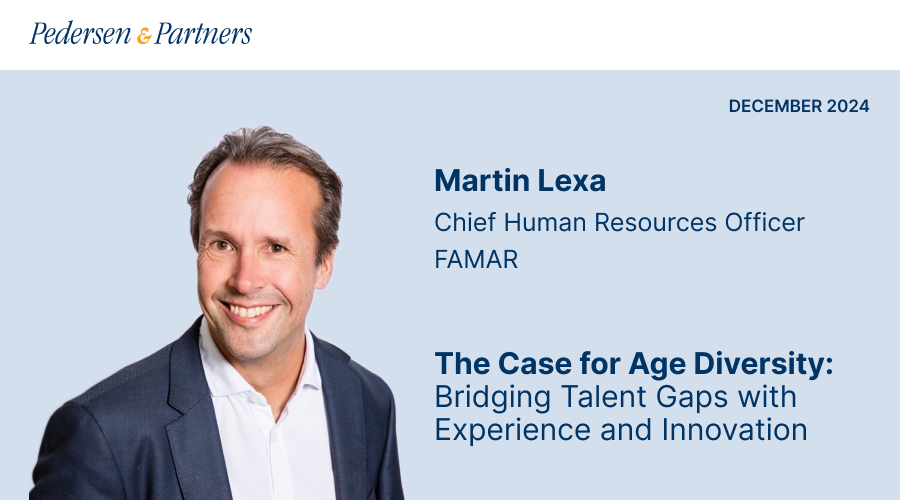The Case for Age Diversity: Bridging Talent Gaps with Experience and Innovation
December 2024
By Sandra Roels, Client Partner at Pedersen & Partners.
Diversity, equity, and inclusion (DE&I) efforts often focus on gender and ethnicity, but age diversity remains a largely untapped and overlooked resource. The recent Live Talk – DE&I Series, hosted by Pedersen & Partners and moderated by Sandra Roels, Client Partner at Pedersen & Partners, shed light on this critical issue.
Featuring insights from Martin Lexa, CHRO at FAMAR, an experienced HR leader in the pharmaceutical industry, the discussion highlighted why age diversity is essential for building resilient, high-performing organisations.
Global Talent Shortages: A Problem We Can’t Ignore
According to McKinsey, the global labour market is projected to face 85 million unfilled jobs by 2030. This looming crisis stems from several factors:
Aging Populations
- Many developed countries are experiencing declining birth rates and longer life expectancies, resulting in fewer young workers entering the labour market.
Evolving Work Expectations
- Employees now demand flexibility, autonomy, and roles that align with their values, making traditional recruitment strategies less effective.
Skills Gaps
- Despite technological advancements, many roles require specific expertise that younger generations may not yet possess.
As Lexa mentioned, “Whether we like it or not, the talent shortage will not go away. It’s here to stay.”
Why Age Diversity Matters
Age diversity offers a solution to the talent shortage while driving significant business benefits. Studies reveal that companies with a 10% higher share of employees over 50 enjoy:
1.1% higher productivity
- Senior professionals bring extensive experience and technical expertise to their roles, fostering efficiency.
4% lower turnover
- A multi-generational workforce leads to greater employee satisfaction and stability.
Improved leadership performance
- Organisations with more experienced management teams outperform their peers, as seasoned leaders often possess better decision-making skills and strategic foresight.
Additionally, older employees often exhibit qualities such as mentorship, team collaboration and a commitment to knowledge sharing. Categorized as “givers” or “artisans", they prioritize autonomy, intellectual challenges, and contributing to organisational success.
Overcoming Barriers to Age Diversity
Despite the benefits, many organizations hesitate to hire senior professionals due to biases around cost, adaptability, and succession planning. Changing this mindset requires:
Educating Leadership
- Business leaders must understand the tangible value of age diversity through data and case studies.
Adopting Flexible Hiring Models
- Senior professionals often seek part-time roles, consultancy agreements, or interim positions rather than full-time, permanent employment.
Targeted Recruitment
- Identifying specific roles where senior expertise can make the most impact - such as mentoring successors or addressing skills gaps - can unlock the potential of this talent pool.
Creating Inclusive Workplaces for All Generations
For age diversity to succeed, companies must foster an environment where multigenerational teams thrive. Key strategies include:
Cross-Generational Collaboration
- Pairing senior and junior employees enables knowledge transfer and innovative problem-solving.
Flexible Work Arrangements
- Allowing older professionals to choose their hours or work remotely increases engagement and productivity.
Custom Compensation Packages
- Benefits that reflect the priorities of older workers should be made available, such as healthcare options rather than long-term pension contributions.
Structured Mentorship Programmes
- Well-implemented mentorship programmes will ensure that the expertise and knowledge of senior professionals is not lost, but is effectively transferred to the next generation of leaders.
A Case in Point: Leveraging Senior Talent
During the session, Martin Lexa shared a real-world example of integrating age diversity into talent strategy. In a competitive talent market, Lexa faced challenges hiring a Chief Operating Officer (COO). Recognizing that traditional approaches were ineffective, he hired a 65-year-old professional who had the necessary expertise. This senior COO not only stabilised operations but also worked with the company to mentor and prepare a younger successor over a two-year period.
“Bringing in senior professionals can be a win-win,” Lexa explained. “They bring immediate value while helping to develop the next generation of leaders.”
The Role of Executive Search Firms
Executive search professionals play a pivotal role in advancing age diversity. By advising clients to broaden their candidate pools and addressing pre-conceived biases, Pedersen & Partners supports organisations in aligning their hiring strategies with tthe demands of oday’s competitive talent market.
As Sandra Roels noted: “Clients often seek mid-career candidates with potential for growth, but age diversity opens up a wealth of possibilities. We can support clients by presenting data and stories that showcase the value of thinking beyond traditional hiring norms.”
Looking Ahead: The Future of Work
The Conversation during the Live Talk underscored a fundamental shift in the workforce: age diversity is no longer optional but essential for companies seeking to thrive in an increasingly complex and competitive landscape. Organisations must adapt their DE&I strategies to include all dimensions of diversity, including age, if they are to remain innovative and resilient.
As companies rethink their talent strategies, embracing age diversity offers a powerful opportunity to bridge gaps, foster collaboration, and unlock the potential of a truly multi-generational workforce. By taking deliberate steps today, businesses can secure a stronger, more inclusive future.

